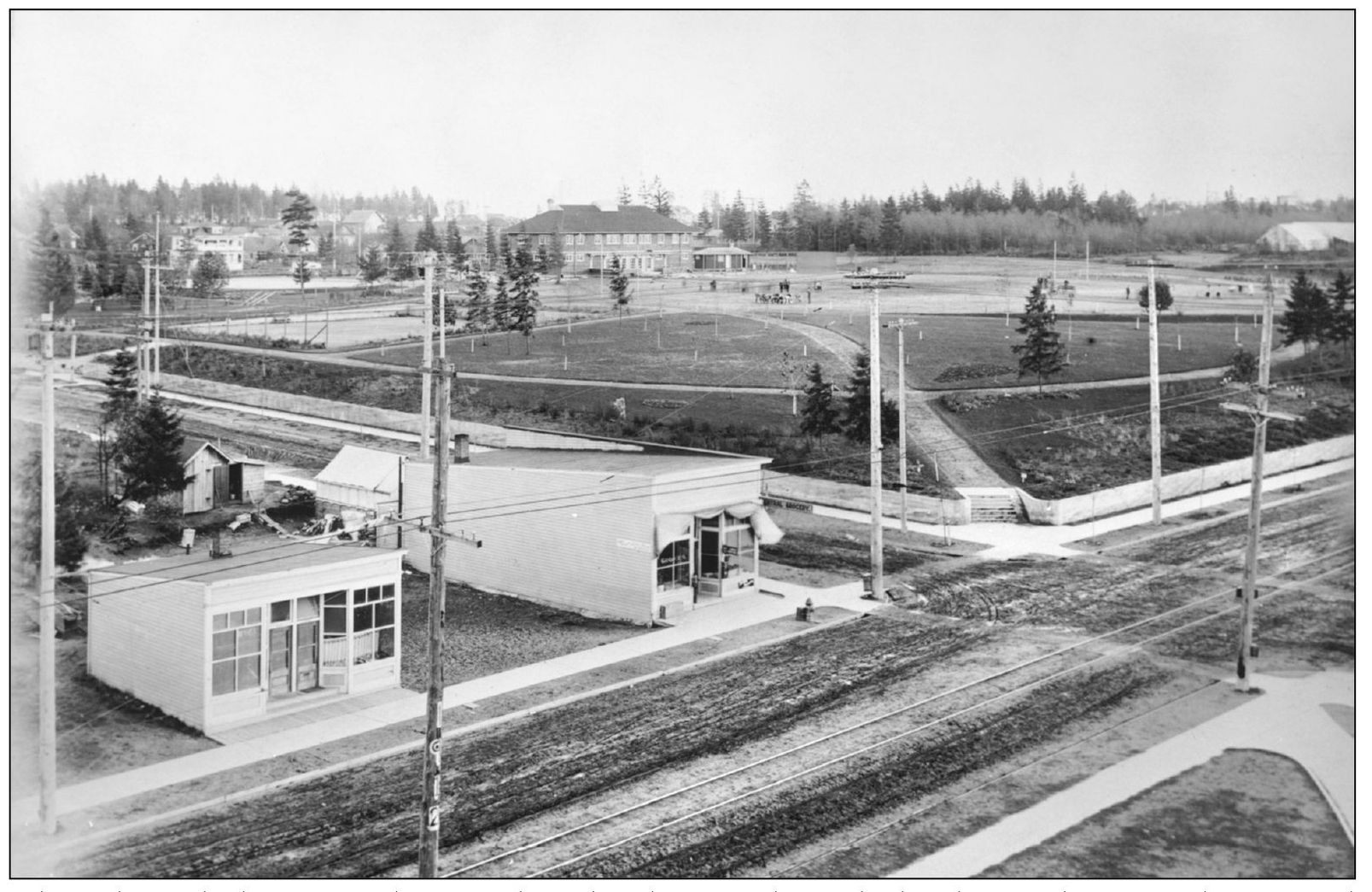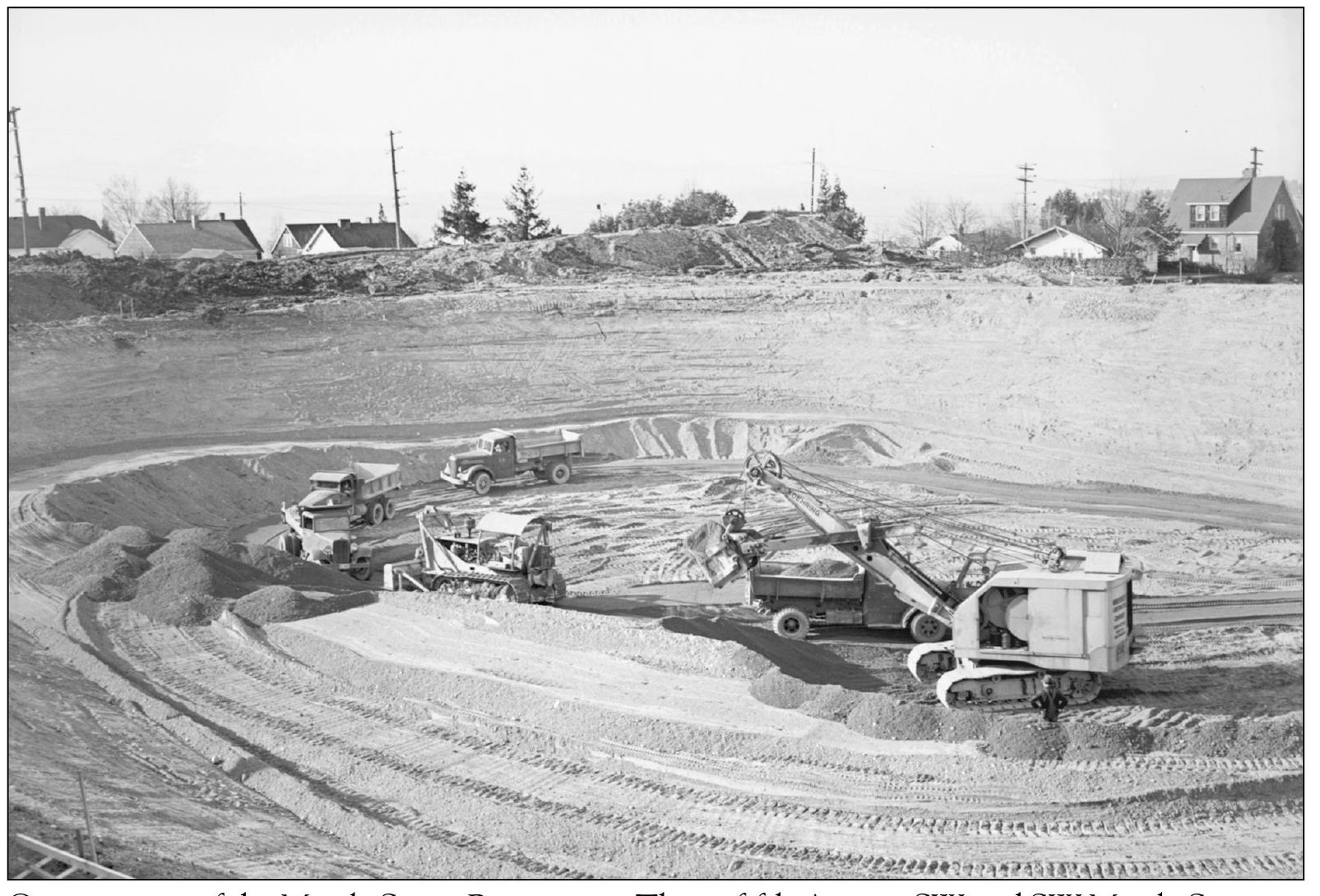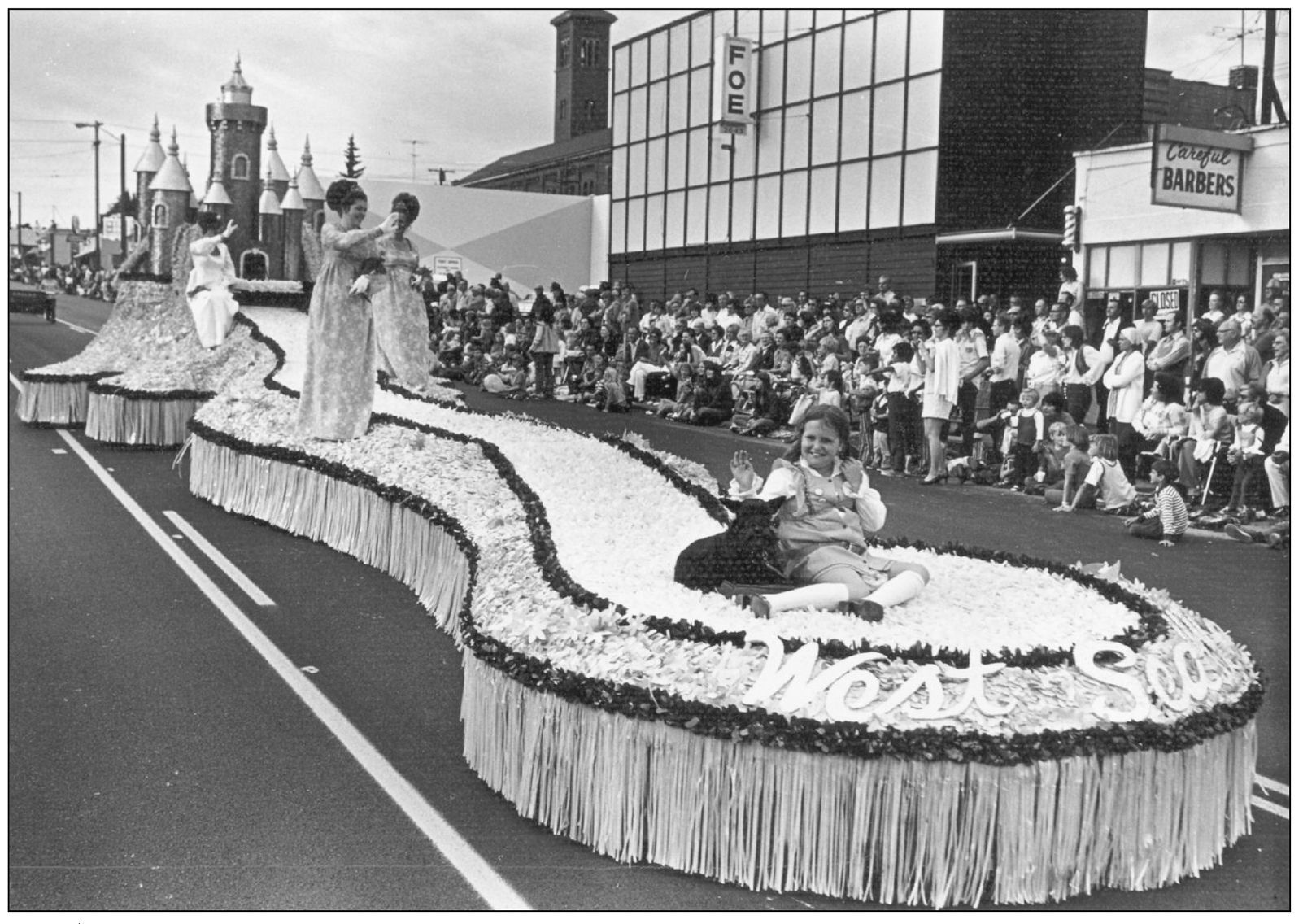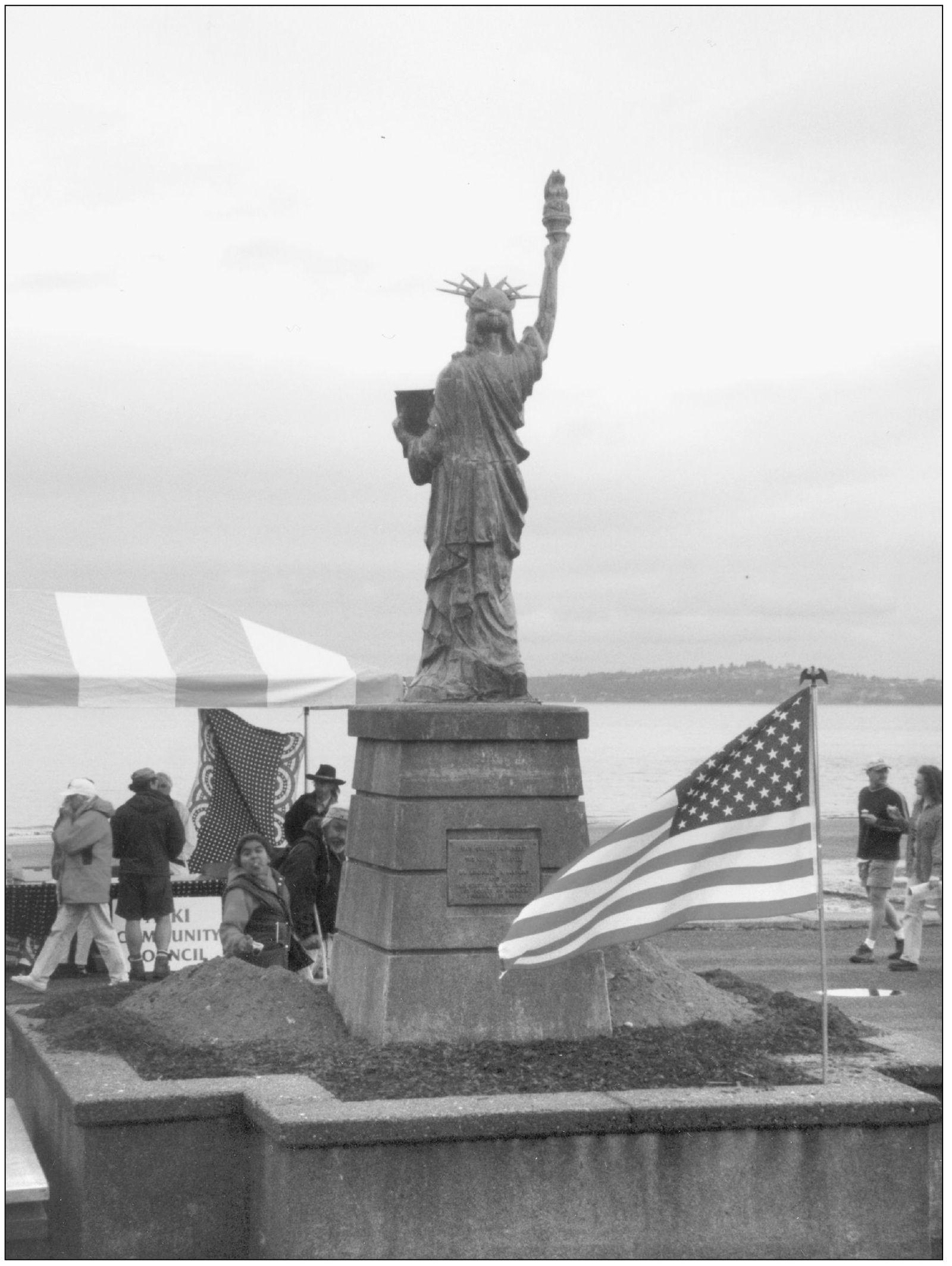Eight
COMMUNITY

The White Center Mardi Gras parade comes back to life in 1947 after an 11-year absence. The event included flower shows, carnival rides, and Wild West horseback riding by the South Seattle Saddle Club. This view looks north along Sixteenth Avenue SW.

John Olmsted, the son of the famed Frederick Law Olmsted who designed New York’s Central Park, laid out Hiawatha Playfield, shown in the photograph above around 1911, as part of a planned network of Seattle parks. It opened in 1910, and at the time it was the largest playfield in the city. In 1911, a field house (later renamed a community center) became the first public recreation building in Seattle. Gym classes and school dances were held at the center and playfield. The photograph below shows a May Day celebration in 1914. Students from schools all over West Seattle would attend the May fete, and girls would wind bright streamers around the maypole, wrapping it in a colorful pattern. During World War II, between 140 and 160 soldiers camped in tents on the playfield, and officers used the field house as a defense headquarters to guard against possible air attacks on Boeing and the Duwamish shipyards. (Courtesy Seattle Municipal Archives, No. 29297 and No. 29274.)


The beautiful grounds and building of Saint Vincent Home for the Elderly, now called Providence Mount Saint Vincent, are shown as they appeared around 1924. The complex had sweeping views and included an orchard and several ponds. The original home was established in Vancouver, Washington Territory, and relocated to the current location in West Seattle on January 25, 1924. (Courtesy Providence Mount Saint Vincent.)

First Lady Eleanor Roosevelt attended the 1941 dedication of Camp Long after visiting it during the planning stages. Built as a Works Progress Administration (WPA) project between 1937 and 1940, the 68-acre park was named for Judge William G. Long, a juvenile court judge and strong youth advocate. Clark Schurman, a nationally known mountain climber and scoutmaster, designed the park along with Ben Evans of the Seattle Parks Department. (Courtesy Seattle Municipal Archives, No. 30573.)

Girst Scouts salute the U.S. flag at Camp Long in the late 1950s. They stand in front of one of 10 arts and crafts rustic-style cabins that were built in 1938. Camp Long, the West Seattle Golf Course, and the West Seattle Stadium were all WPA projects. Lumber from dismantled local buildings was recycled to erect these structures.

West Seattle Stadium, shown here in 1937, was originally intended for the Camp Long site. The West Seattle Athletic League played the first football game at the stadium in 1938 before its completion in 1939. The original grandstand on the north side of the field is still standing, but the wooden bleachers were replaced by concrete ones in 1961. (Courtesy Seattle Municipal Archives, No. 30646.)

This view is of the Hi-Yu Carnival at the West Seattle Stadium in 1960. The carnival started at the West Seattle Stadium in 1951 and was an annual event until 1984. The weeklong carnival included rides, games, booths, and wrestling matches. After the grand parade, drum and bugle corps would assemble at the stadium for a competition, which was followed by a big fireworks display. (Courtesy Seattle Municipal Archives, No. 30679.)

Dubbed the “Cheese Box,” this YMCA building at Thirty-ninth Avenue SW and Fauntleroy Way SW is shown here around 1930 and opened on February 2, 1925. This building later expanded to include an outside playfield and tennis court.

The Folts Motors building, shown here in 1935, was originally part of the West Seattle Dairy and became the home of the YMCA in 1942. The YMCA paid just $15,000 to acquire the building, though it was worth $135,000. After the building was demolished, the site would later become Huling Brothers Chrysler-Jeep.

Two young YMCA members gather bars of soap to sell and earn their way to summer camp, around 1960. The West Seattle “Y” would finally include activities for girls in 1943.

The purpose of the YMCA in 1922 was to “stimulate the growth of its youth into better manhood through clean and wholesome recreational activities.” Activities would eventually include basketball, swimming, and shop classes in the 1960s.

This tough-looking group of West Seattle Baseball Club players was managed by the even tougher appearing Paris brothers—Ben and Jack in the center of the second row.

This is a view looking down a trail at Schmitz Park around 1910. Ferdinand Schmitz acquired land in 1887 and saved it from being logged off. In 1908, he and his wife, Emma, donated 30 acres of their land to the City of Seattle under the provision that it be preserved to represent the original forest “cathedral” the settlers found when they first colonized the area.

The Schmitz estate home, located on the hillside now within Me-Kwa-Mooks Park, was also named San Souci, which is French for “without worry.” Beach Drive area residents relax on the Schmitz family yacht San Souci II around 1920.

Over 700 homes, mainly duplexes, were built at High Point to provide housing for wartime defense workers and, later, returning war veterans to Seattle. In many families, both parents worked, and community residents helped one another to care for the children. The High Point Community Center was busy with events such as this 1943 Halloween party. As Seattle’s needs changed, so did High Point. No longer needed for military, in 1953 High Point became public housing, and in 2003 was fully demolished to become a vibrant mixed-income community. (Above courtesy MOHAI, PI 23331; below courtesy SWSHS.)


Around 1923, these nine wooden water tanks at Fortieth SW and SW Charlestown Street served the entire West Seattle area. A 1-million-gallon steel tank replaced the wooden tanks in 1927. The replacement tank remains in service today. (Courtesy Seattle Municipal Archives, No. 50562.)

Construction of the Myrtle Street Reservoir at Thirty-fifth Avenue SW and SW Myrtle Street in the High Point neighborhood is shown in February 1947. The reservoir site is the highest point in Seattle. Current plans for a viewpoint park area include an open grass area planted over the lidded reservoir and walking paths. (Courtesy Seattle Municipal Archives, No. 40749.)

The Seafair Pirates land at Alki Beach during Hi-Yu Celebration on August 4, 1966. The first pirates were sponsored by the West Seattle Lions Club and landed at Alki around 1934 aboard the Yankee Clipper, which also participated in the 2001 Seattle sesquicentennial. The raucous pirates’ landing continues to be a popular Seafair event today with coins and necklaces tossed to waiting children and adults.

The 1962 Hi-Yu celebration court gathers on the lawn in front of the Alki Homestead Restaurant. The princesses are competing to be Miss West Seattle.

Local Moe Beerman created the standout float of 1973, “Magical Moments in the Land of Oz.” The West Seattle American Legion Post No. 160 has always organized the parade. It takes true dedication some years to watch the Hi-Yu parade under gray skies with cold Seattle weather. The word hiyu originates from the Chinook trade jargon and means gathering or party.


Famed actress Frances Farmer, during her junior year at West Seattle High School in 1930, was active in debate, writing, and student government. Farmer was accepted to the University of Washington where she starred in student stage productions before being contracted with Paramount Pictures in Hollywood. She drew national attention when her high school student paper, “God Dies,” won a Scholastic magazine award. The ensuing controversy negatively impacted her view of hometown West Seattle.

Diane Friesen was voted Miss West Seattle during the 1955 Hi-Yu. Most recognize her now as actress Dyan Cannon. She graduated from West Seattle High School in 1954.

In 1952, the Seattle Council of the Boy Scouts of America unveiled their donation to the people of Seattle—a Little Sister of Liberty. Over the following 55 years, the thin shell of metal endured salt water, weather, and vandalism until replaced in 2008 with a solid bronze Statue of Liberty. The original intent was to inspire patriotic gatherings, and since that first unveiling, it has become a landmark and meeting place. The first statue still stands nearby, inside the climate-controlled Log House Museum.